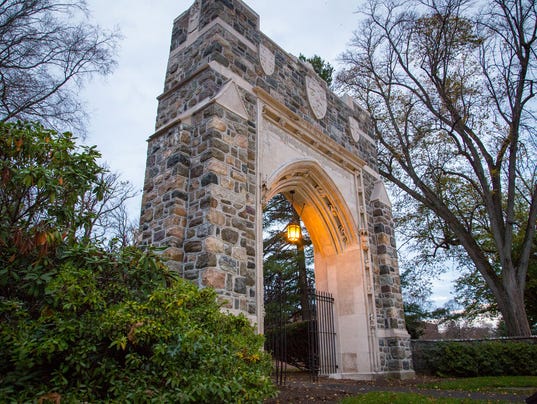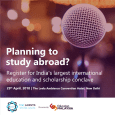
MADISON — Drew University is tops in New Jersey when it comes to attracting international students and sending students abroad to study, according to an Institute of International Education report.
According to the report, Drew ranks in the top 10 percent in enrolling international students and the top 15 percent in undergraduate students studying abroad. Drew is the only New Jersey school in the report’s Top 40 rankings. More than 2,000 of 3,000 accredited colleges responded to the IIE’s survey for the Open Doors Report.
Drew ranks 19th among baccalaureate schools nationwide for enrolling international students, among more than 300 baccalaureate colleges. They ranked 30th for undergraduate participation in study abroad programs among about 250 baccalaureate colleges that give credit for studying abroad. Drew was the only baccalaureate college or university in New Jersey to be ranked by IIE for its undergraduate participation rate.
“Drew has built a solid record for both incorporating international students into our community and providing dozens of study abroad opportunities,” President MaryAnn Baenninger said. “So, all our students, international and domestic, learn and use skills that matter in a global economy.”
Study abroad programs at Drew run through the school’s Center for Global Education, which connects students to more than a dozen options. The list includes Italy, France, Greece, the U.K., China, South Korea and Ghana. The most popular destinations offered are Ireland, South Africa, and Spain.
While fewer new international students are coming to the United States overall, according to the report, Drew has doubled its total international students between fall 2013 and fall 2016, in-line with a rise in enrollment for all students. Drew has gone from a low of 1,482 undergraduates in 2014, when the Baenninger arrived, to 1,602 today.
Of the 172 international students in the fall of 2014, 60 were new. In fall 2015, the 230 international students, 69 new, at Drew represented 11 percent of its total population. In fall 2016, those figures climbed to 297, 105 and 14 percent, respectively.
Robert Massa, senior vice president of enrollment and institutional planning at Drew said the numbers have increased over the past few years for two reasons.
“First, we have a regional recruiter based in Prague and one on the west coast who also recruits in Asia. We have also been recruiting heavily at U.S. boarding schools that enroll a large number of internationals, so building relationships with high school counselors here and abroad is critical,” Massa said.
“Second, we contracted four years ago with INTO University Partnerships to bring to Drew students who were not quite ready to be fully admitted to a university in the U.S., but who could benefit from English as a Second Language courses and a full two-year for-credit pathway program.”
This fall, Drew has 356 international students, including 98 new ones, indicating the overall number is beginning to flatten out. That trend is reflected nationally.
Massa said Drew could have accepted more international students this year but chose not to so they could offer more aid to the students they admitted.
“This year’s international pool seemed to need more financial help than did last year’s,” Massa said. “Combined with the fact that our domestic pool was needier and we needed to focus resources there, we could admit fewer internationals. So the demand was there, but the resources to fund those students weren’t sufficient to admit a larger number.”
While new international student enrollment has dropped off nationally – 301,000 students in the 2015-16 academic year to 291,000 in the new report – overall, 2016-17 was a record year.
The Open Doors report showed 1.078 million total international students in the U.S., 5.3 percent of all students. Those figures both exceed last year’s records of 1.043 million and 5.2 percent, respectively. The number is up overall because while fewer new students arrived this year than last, more came than did four years earlier, replacing that amount.
In New Jersey, most international students come to the U.S. from China (38.9 percent) and India (27.3), according to the report. The state took in nearly 23,000 students in the 2016-17 academic year, up seven percent from the last report.
“Direct admission students come from Brazil, Canada, the Czech Republic, Georgia, India, China, Japan, Kenya, Mexico, Nepal, Russia, South Africa and Turkey to name a few,” Massa said. “Many of our pathway students are coming from China and India, but they really are from all over. “
There were 182 Drew students who studied abroad in the 2015-16 academic year, as opposed to 101 in 2014-15. The Open Doors report takes international student data from 2016-17, and study abroad data from 2015-16. Drew’s numbers also include the Caspersen School of Graduate Studies and Theological School.
Marianna Goncalves Severgnini, a senior from Madison, spent part of this summer studying abroad in southern Italy.
“It was truly amazing. It was an overview course about Italy, from the plants, to the region’s diet and lifestyle, to the history,” Severgnini said. “As a minor in Italian it was a good way to put everything together. And I have Italian heritage, so I was always curious to learn more about the culture and experience what it’s like to live there.”
While she always had an interest in traveling, Severgnini did not attend Drew planning to study abroad.
“My professor told me about the course and I thought it would be a good opportunity,” Severgnini said. “This has really piqued my interest. I fell in love with the culture and lifestyle of Italy, and I could see myself moving there for a little bit after college.”
While the four-credit course was in English, Severgnini said the month spent in the country helped her practice her Italian and experience things about the region she could not know from just sitting in a classroom.
“I definitely recommend studying abroad,” Severginini said. “I think there is a lot to gain by having that experience, going away from your comfort zone and trying new things.”
Based in Madison, Drew University is a private school with a current tuition of just over $48,000, plus $14,000 for room and board. It currently boasts an enrollment of more than 2,000 students, with more than 60 percent of students coming from New Jersey.
About 80 percent of students receive financial aid, with an average of $39,700 per year, $29,000 of which came from scholarships and grants.
International students pay the same tuition as students who are U.S. citizens.
“On average, international students are receiving less aid than U.S. citizens to attend American colleges and universities at the undergraduate level and thus are paying more out-of-pocket,” Massa said. “This is true at Drew as well, where the average discount for U.S. citizens next year is projected to be about 50 percent, whereas for international students, the discount would be in the 30 percent range on average.”
Starting next year, Drew will cut tuition by 20 percent to just over $38,000 per year, making up the difference by offering less financial aid, $32 million compared to $35 million in 2017.
[“Source-dailyrecord”]




